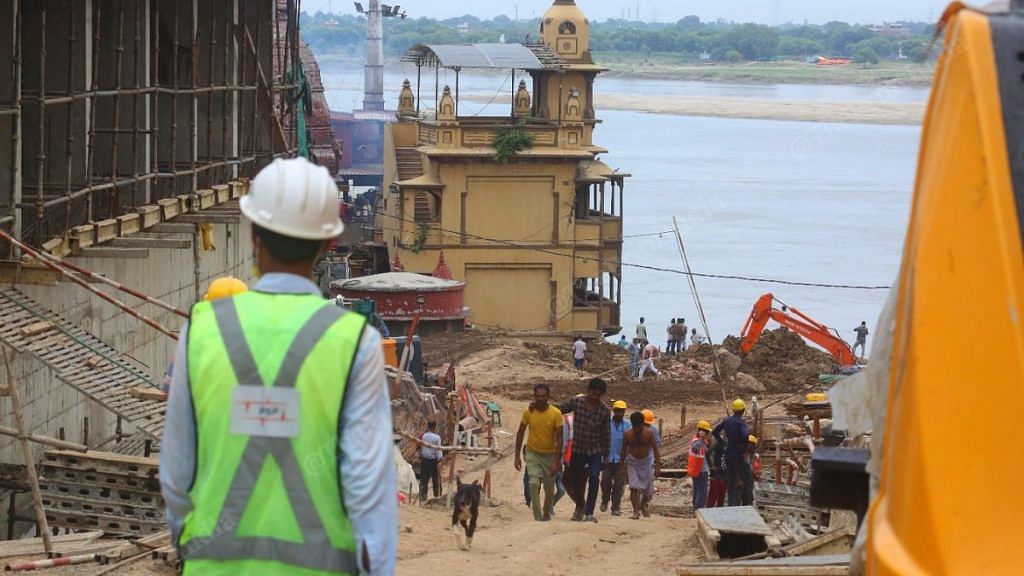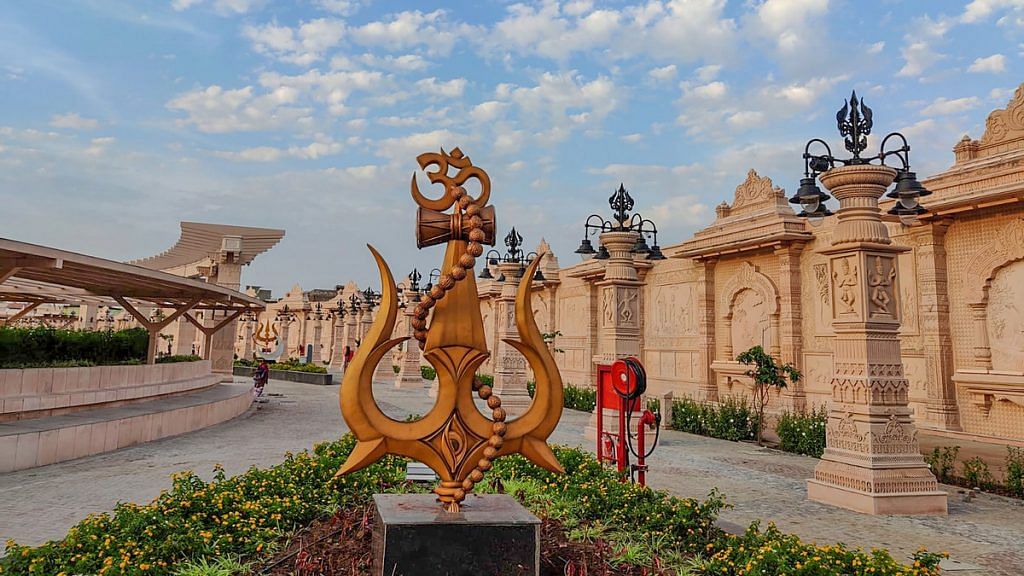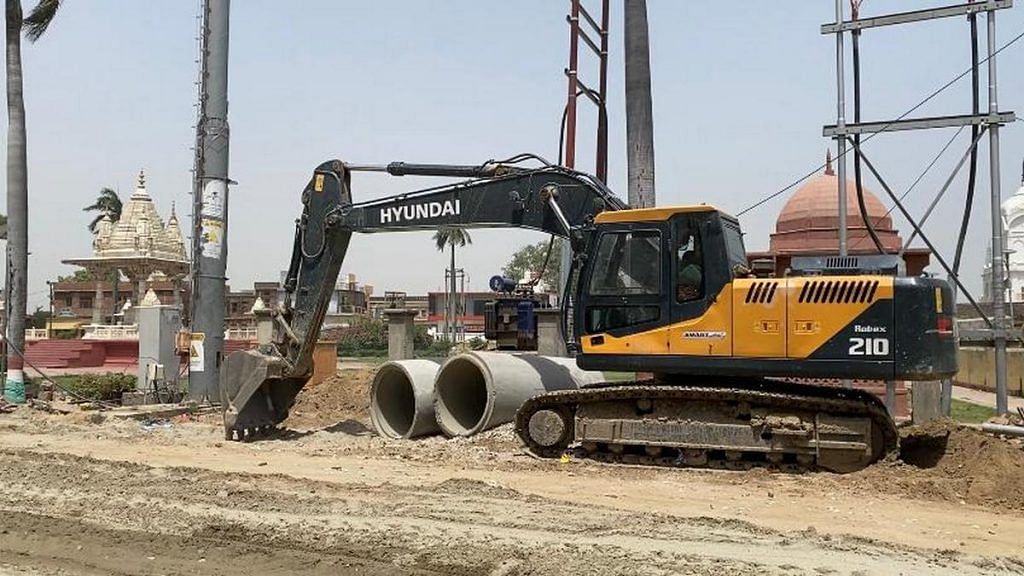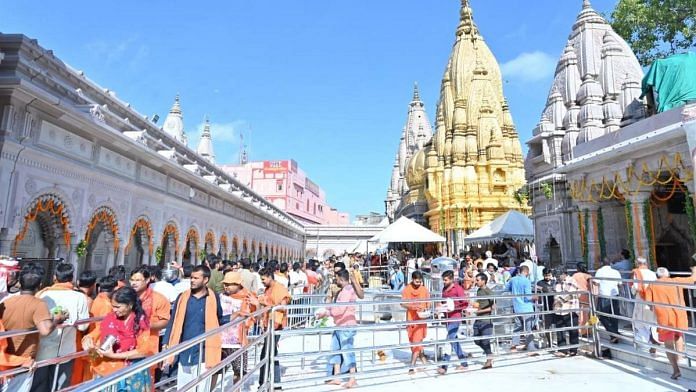New Delhi: When Prime Minister Narendra Modi inaugurated Varanasi’s Kashi Vishwanath Dham corridor in December 2021, he declared that the temple complex could now accommodate 50,000 to 75,000 devotees owing to its expansion from 3,000 sq ft to 5 lakh sq ft. However, the daily influx of visitors has far surpassed this, leaving Varanasi’s infrastructure groaning under pressure.
The temple corridor currently witnesses around 1.5-2 lakh visitors daily, with the number spiking to nearly 5 lakh on festivals and Mondays, especially during the ongoing Shravan month, claimed Sunil Kumar Verma, the chief executive officer of the Kashi Vishwanath Temple Trust, who also serves as the secretary of the Varanasi Development Authority.
Nearly 7 crore people visited the holy city last year, according to him.
While this surge in footfalls has boosted the local economy, with a sharp rise in demand for hotels, restaurants, private transport, and more, it has also strained the existing infrastructure.
The city now faces challenges such as traffic congestion, lack of parking space, issues with public transport, an increase in solid waste, and a heightened demand for water.
The city administration and municipal corporation have now sanctioned several projects to alleviate these burdens, from building new flyovers to upgrading public transport. Work on some projects, like the ring road, started while the corridor was being developed.
In Ujjain, another temple town with an upgraded corridor, it’s much the same story.
Since the opening of phase-I of the 900-metre Mahakal Lok Corridor at the Mahakaleshwar temple in October 2022, there has been an economic boom matched by an infra burden. Here too, city authorities are currently executing remedial measures, including decongestion and better waste management.
Meanwhile, Ayodhya presents a distinct case. While Varanasi and Ujjain are currently upgrading their public amenities, in Ayodhya, infra upgradation work is being carried out simultaneously with the construction of the Ram Temple, which is likely to be inaugurated in January next year.
ThePrint spoke to locals and officials to find out how the increase in footfall has affected these temple towns, as well as their efforts to address the associated challenges.
Also Read: Agra & Varanasi among 4 UP cities set to issue municipal bonds to raise money for infra development
Varanasi
The opening of the Kashi Vishwanath corridor has led to major changes in the historic city in the last one-and-a-half-years.
There isn’t much scope for road widening to ease traffic congestion emanating from the increased footfall, but the city administration has taken other measures — such as constructing new flyovers and building a new ring road, said Varanasi district magistrate (DM) S Rajalingam, speaking to ThePrint.
“Now we have constructed the ring road, which was not there earlier, where heavy traffic is diverted. Various options are being or have been developed to provide smooth access for pilgrims to the temple complex,” he said.
To improve the public transport system, 300 electric buses are being procured, and a ropeway from Varanasi Cantonment railway station to the temple complex is under construction.

Varanasi Development Authority (VDA) secretary Verma said that various measures are also being undertaken for the long-term development of the city.
“City development plans are being prepared by various authorities such as the municipal corporations and VDA. A comprehensive development plan or vision document is also being worked out, considering the requirement of the city in the next two-three decades,” he said.
Despite all the infrastructural challenges, officials said that the development of the temple complex has given a boost to the local economy.
“It has helped local traders and businesses in a big way as demand for hotels, taxis, restaurants etc have gone up. The municipal corporation revenue, especially from advertisement, has also increased,” said Varanasi municipal commissioner Sipu Giri.
Many locals have capitalised on the business opportunities arising from the increased visitors, converting their homes into budget hotels or offering bed-and-breakfast accommodations.
“There is an exponential increase in the demand for hotels as we get a large number of visitors throughout the year. Earlier, we used to see this kind of a rush only during festival seasons,” said Varanasi resident Akhilesh Mishra, who has a hotel and transportation business.
“The demand for rooms has become a good source of income for locals, though new hotels, including five-star facilities, are also under construction,” he added.
Ujjain
The once-sleepy temple town of Ujjain in Madhya Pradesh has been buzzing with activity since the inauguration last October of phase-I of the Rs 850-crore Mahakal Lok Corridor project, which sprawls over 2-5 hectares (6 acres).
Speaking to ThePrint, Ujjain mayor Mukesh Tatwal said that locals had converted approximately 500-600 ancestral homes around the corridor into hotels or B&Bs.
Ujjain district magistrate Kumar Purushottam also confirmed that the corridor has been an economic blessing for locals.
Nevertheless, the increased stream of visitors has also strained the civic infrastructure catering to the city of 10 lakh people.

According to Sandeep Soni, administrator of Mahakal temple, close to 1.5-2 lakh devotees visit the newly developed temple corridor daily. The number goes up to 5 lakhs per day during festivals or special days such as Monday, he added.
“We didn’t expect this kind of daily footfall. It has put a lot of pressure on civic infrastructure. Parking has become a major challenge and we are working on a plan to increase space,” Tatwal said, noting that the flow of visitors had increased not just to the Mahakal temple, but also to other places of worship in the vicinity.
To tackle traffic congestion and increased solid waste generation, the city administration and the Ujjain municipal corporation have undertaken various infrastructure projects.
Although there is limited scope for road widening around the temple complex, which is located in the old part of the city, a “comprehensive mobility and decongestion plan” has been prepared, Purshottam told ThePrint.
The plan, he said, includes constructing new parking lots, as well as means to connect these with the temple complex.
“A ropeway will be constructed between the railway station and the temple complex. We are also considering the possibility of constructing a skywalk,” Purushottam added.
The municipal corporation, meanwhile, has ramped up staff and vehicles for sanitation services, as daily waste generation has almost doubled.
“The daily waste generation has increased from 160-170 MT (metric tonnes) to 225-240 MT. Around the temple complex, we have deployed close to 1,700-1,800 sanitation workers, which is almost half of our total sanitation staff,” said Roshan Kumar Singh, commissioner of the Ujjain municipal corporation.
In addition, the municipal body has also adopted two innovative ways to recycle floral and cloth waste from the temple complex and other religious sites.
“At Mahakal Lok, the floral waste generation is around 2-4MT daily. We have started a 5MT plant to process floral waste to make incense sticks, Holi colours, and so on. At another plant, we make paper and paper products from cloth pieces left by visitors on the ghats. Both the plants are run by women’s self-help groups,” Singh explained.
Also Read: Frenetic work in Ayodhya — ‘Rs 3,200 cr collected, mandir 45% complete, darshan by Jan 2024’
Ayodhya
In contrast to Varanasi and Ujjain, infrastructure upgradation work in Ayodhya is being carried on in tandem with the construction of the Ram Temple.
The temple is being built in three phases, with phase-I, involving the sanctum sanctorum, expected to be completed by the end of this year.
Already, development projects worth Rs 32,000 crore are being implemented in the city, according to Uttar Pradesh Chief Minister Yogi Adityanath.
With close to five lakh people expected to visit the city daily, several large-scale projects are already underway, from widening roads, to ramping up hospitality infrastructure, to upgrading the water supply, officials said.

Guiding the way is a far-sighted vision document. “We have adopted a different approach to cater to the increased footfall in Ayodhya after the inauguration of the Ram temple. We have developed a vision plan for 2047 which covers all aspects of city planning to meet the requirements of pilgrims, tourists, and locals,” said Vishal Singh, who serves both as the city’s municipal commissioner and the vice-chairman of the Ayodhya Development Authority (ADA).
“All the projects related to parking, water supply, sewer lines, etc are being taken up in line with the vision document,” he added.
The biggest challenge, officials say, will be in managing vehicular traffic in the city, but work is already in progress, including widening arterial roads.
“At the entry points to the city, the carriageways will be four or six lanes. We are also planning two layers of ring road for smooth movement of traffic,” Singh said.
Parking infrastructure is also being significantly expanded.
“Six parking lots with space for 2,000 cars each have been constructed around the temple complex. We are in the process of acquiring 5 hectares of land at each entry point to create a welcome facility for tourists and pilgrims, along with a parking facility for 30,000 buses,” Singh added.
The biggest challenge will be managing vehicular traffic in the city. Widening all arterial roads is underway, with four to six-lane carriageways planned at entry points. Additionally, two layers of Ring Road are in the works to ensure smooth traffic flow. Six parking lots, each accommodating 2,000 cars, have been constructed around the temple complex. Land acquisition is underway at entry points to create welcome facilities for tourists/pilgrims and parking space for 30,000 buses.
The area under the ADA was increased from 135 sq km to 873 sq km in 2021, said a senior official from the development body, to accommodate heightened requirements and facilitate the development of new facilities.
He said development plans for the newly added areas are being prepared.
Meanwhile, to address the anticipated surge in waste generation, currently at 150-200 MT daily, the municipal corporation is establishing a new solid waste treatment plant.
Ayodhya mayor Girish Pati Tripathi told ThePrint that work was also progressing rapidly to increase the capacity of the hospitality sector.
“We will require all kinds of hotels, from premium to budget to dharamshalas, to meet the requirement of people,” he said. “We have sanctioned a lot of hotel projects in the past few months. In addition to this, locals are being allowed to provide homestay facilities.”
(Edited by Asavari Singh)
Also Read: How Ujjain’s Mahakal Lok is using AI, facial recognition to manage temple’s crowds & ensure security



